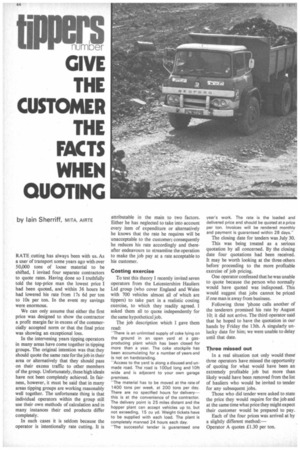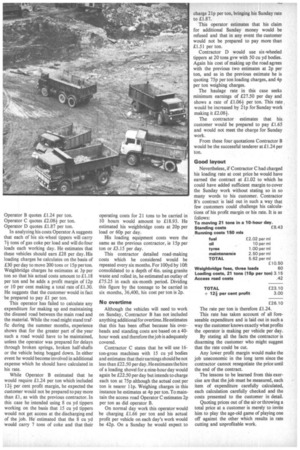GIVE THE CUSTOMER • THE FACTS WHEN QUOTING
Page 46

Page 47

If you've noticed an error in this article please click here to report it so we can fix it.
by lain Sherriff, MITA, AIRTE RATE. cutting has always been with us. As a user of transport some years ago with over 50,000 tons of loose material to be shifted, I invited four separate contractors to quote rates. Having done so I truthfully told the top-price man the lowest price I had been quoted, and within 36 hours he had lowered his rate from 17s 6d per ton to lOs per ton. In the event my savings were enormous.
We can only assume that either the first price was designed to show the contractor a profit margin far in excess of the commercially accepted norm or that the final price was showing an exceptional loss.
In the intervening years tipping operators in many areas have come together in tipping groups. The original intention was that they should quote the same rate for the job in their area or alternatively that they should pass on their excess traffic to other members of the group. Unfortunately, these high ideals have not been completely achieved. In fairness, however, it must be said that in many areas tipping groups are working reasonably well together. The unfortunate thing is that individual operators within the group still use their own methods of calculation and in many instances their end products differ completely.
In such cases it is seldom because the operator is intentionally rate cutting. It is attributable in the main to two factors. Either he has neglected to take into account every item of expenditure or alternatively he knows that the rate he requires will be unacceptable to the customer; consequently he reduces his rate accordingly and thereafter endeavours to streamline the operation to make the job pay at a rate acceptable to his customer.
Costing exercise
To test this theory I recently invited seven operators from the Leicestershire Hauliers Ltd group (who cover England and Wales with 700 vehicles almost all of which are tippers) to take part in a realistic costing exercise, to which they readily agreed. I asked them all to quote independently for the same hypothetical job.
The job description which I gave them read:
"There is an unlimited supply of coke lying on the ground in an open yard at a gasproducing plant which has been closed for more than a year. The coke stockpile has been accumulating for a number of years and is not on hardstanding,
"Access to the yard is along a disused and unmade road. The road is 100yd long and 10ft wide and is adjacent to your own garage premises.
''The material has to be moved at the rate of 1400 tons per week. at 200 tons per day. There are no specified hours for delivery-this is at the convenience of the contractor. The delivery point is 25 miles distant and the hopper plant can accept vehicles up to, but not exceeding. 15 cu yd. Weight tickets have to be supplied with each load. The plant is completely manned 24 hours each day.
"The successful tender is guaranteed one year's work. The rate is the loaded and delivered price and should be quoted at a price per ton. Invoices will be rendered monthly and payment is guaranteed within 28 days."
The closing date for tenders was July 30.
This was being treated as a serious quotation by all concerned. By the closing date four quotations had been received. It may be worth looking at the three others before proceeding to the more profitable exercise of job pricing.
One operator confessed that he was unable to quote because the person who normally would have quoted was indisposed. This would suggest that jobs cannot be priced if one man is away from business.
Following three 'phone calls another of the tenderers promised his rate by August 10; it did not arrive. The third operator said that he hoped to have the quotation in our hands by Friday the 13th. A singularly unlucky date for him; we were unable to delay until that date.
Tree missed out
In a real situation not only would these three operators have missed the opportunity of quoting for what would have been an extremely profitable job but more than likely would have been removed from the list of hauliers who would be invited to tender for any subsequent jobs.
Those who did tender were asked to state the price they would require for the job and at the same time what price they might expect their customer would be prepared to pay.
Each of the four prices was arrived at by a slightly different method:—
Operator A quotes £1.30 per ton. Operator B quotes £1.24 per ton.
Operator C quotes £2.084 per ton.
Operator D quotes £1.87 per ton.
In analyzing his costs Operator A suggests that each of his six-wheel tippers will carry 71 tons of gas coke per load and will do four loads each working day. He estimates that these vehicles should earn £28 per day. His loading charges he calculates on the basis of £30 per day to move 200 tons or 15p per ton. Weighbridge charges he estimates at 3p per ton so that his actual costs amount to £1.18 per ton and he adds a profit margin of 12p or 10 per cent making a total rate of £1.30. He suggests that the customer would in fact be prepared to pay £1 per ton.
This operator has failed to calculate any expenditure for making up and maintaining the disused road between the main road and the material. While the road might stand traffic during the summer months, experience shows that for the greater part of the year such a road would have to be maintained, unless the operator was prepared for delays through broken springs, broken half-shafts or the vehicle being bogged down. In either event he would become involved in additional expense which he should have calculated in his rate.
While Operator B estimated that he would require £1.24 per ton which included 12+ per cent profit margin, he expected the customer would not be prepared to pay more than £1, as with the previous contractor. In this case he intended using 8 cu yd tippers working on the basis that 15 cu yd tippers would not get access at the discharging end of the job. He estimated that the 8 cu yd would carry 7 tons of coke and that their operating costs for 21 tons to be carried in 10 hours would amount to £18.93. He estimated his weighbridge costs at 20p per load or 60p per day.
His loading equipment costs were the same as the previous contractor, ie 15p per ton or £3.15 per day.
This contractor detailed road-making costs which he considered would be repeated every six months. For 100yd by 10ft consolidated to a depth of 4in. using granite waste and rolled in, he estimated an outlay of £75.25 in each six-month period. Dividing this figure by the tonnage to be carried in six months, 36,400, his cost per ton is 2p.
No overtime Although the vehicles will need to work on Sunday, Contractor B has not included anything additional for overtime. He estimates that this has been offset because his overheads and standing costs are based on a 40hour week and therefore the job is adequately covered.
Contractor C states that he will use 16ton-gross machines with 15 Cu yd bodies and estimates that their earnings should be not less than £22.50 per day. He estimates the hire of a loading shovel for a nine-hour day would again be £22.50 per day but intends to charge each ton at 75p although the actual cost per ton is nearer up. Weighing charges in this instance he estimates at 4p per ton. To .maintam the access road Operator C estimates 2p per ton as did operator B.
On normal day work this operator would be charging £1.66 per ton and his actual profit per vehicle on each day's work would be 42p. On a Sunday he would expect to charge 21p per ton, bringing his Sunday rate to £1.87.
This operator estimates that his claim for additional Sunday money would be refused and that in any event the customer would not be prepared to pay more than £1.51 per ton.
Contractor D would use six-wheeled tippers at 20 tons gvw with 50 cu yd bodies. Again his cost of making up the road agrees with the previous two estimates at 2p per ton, and as in the previous estimate he is quoting 75p per ton loading charges, and 4p per ton weighing charges.
The haulage rate in this case seeks minimum earnings of £27.50 per day and shows a rate of £1.06+ per ton. This rate would be increased by 21p for Sunday work making it £2.081.
The contractor estimates that his customer would be prepared to pay £1.65 and would not meet the charge for Sunday work.
From these four quotations Contractor B would be the successful tenderer at £1.24 per ton.
Good layout Nevertheless, if Contractor C had charged his loading rate at cost price he would have earned the contract at £1.02 to which he could have added sufficient margin to cover the Sunday work without stating so in so many words to his customer. Contractor B's contract• is laid out in such a way that few customers could challenge his calculations of his profit margin or his rate. It is as follows:
To moving 21 tons in a 10-hour day.
Standing costs £8.43 Running costs 150 mls fuel £2.02 per ml oil 10 per ml tyres 1.00 per ml maintenance 2.50 per ml TOTAL 5.62 per ml £10.50 Weighbridge fees, three loads 60 Loading costs, 21 tons (15p per ton) 3.15 Access road costs .42 TOTAL £23.10 + 12/ per cent profit 3.00
£26.10 The rate per ton is therefore £1.24.
This rate has taken account of all foreseeable expenditure and is laid out in such a way the customer knows exactly what profits the operator is making per vehicle per day.
By stating all the facts the contractor is disarming the customer who might suggest that the rate could be cut.
Any lower profit margin would make the job uneconomic in the long term since the contractor cannot renegotiate the price until the end of the contract.
The lessons to be learned from this exercise are that the job must be measured, each item of expenditure carefully calculated, each calculation carefully checked and the costs presented to the customer in detail.
Quoting prices out of the air or throwing a total price at a customer is merely to invite him to play the age-old game of playing one off against the other which results in rate cutting and unprofitable work.










































































































































